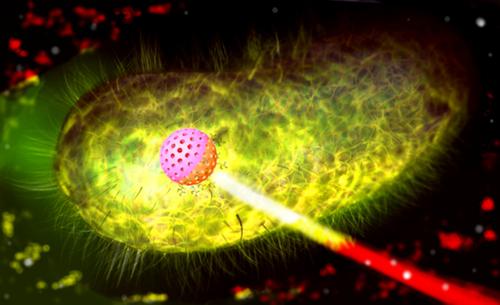当前位置:
X-MOL 学术
›
Microsc. Res. Tech.
›
论文详情
Our official English website, www.x-mol.net, welcomes your
feedback! (Note: you will need to create a separate account there.)
Light‐triggered Janus nanomotor for targeting and photothermal lysis of pathogenic bacteria
Microscopy Research and Technique ( IF 2.0 ) Pub Date : 2020-11-27 , DOI: 10.1002/jemt.23657 Alexandre Loukanov 1, 2
Microscopy Research and Technique ( IF 2.0 ) Pub Date : 2020-11-27 , DOI: 10.1002/jemt.23657 Alexandre Loukanov 1, 2
Affiliation

|
The rapid photothermal lysis of Escherichia coli O157:H7 treated with light‐triggered Janus nanomotors was visualized by Hilbert differential contrast transmission electron microscopy (HDC‐TEM). The extraordinary advantage of this high‐resolution microscopic technique was that it revealed the detailed ultrastructure alterations of the treated cells at a state close to their native one. The micrographs demonstrated that Janus nanomotors (mesoporous silica nanoparticles with gold hemisphere and half‐capped with cysteamine) were able to target and bind to the pathogenic E. coli. The biorecognition reaction proceeded at slightly acid pH thankful to the formed electrostatic adhesion between positively charged amino groups on nanoparticles surface and the negatively charged cell envelope. The exposure of labeled cells to near infrared laser irradiation leaded to occurrence of effective photothermal damage of their plasma membranes, which was enough strong to lyse bacteria. It was because of the overheating obtained by the photon‐to‐thermal conversion reaction generated by the surface plasmon resonance response of Janus nanomotors. The good efficiency of photothermal lysis to inactivate E. coli O157:H7 was confirmed by staining with LIVE/DEAD viability kit and quantification of the few survived cells in epifluorescence microscope. Furthermore, HDC‐TEM images of ice‐embedded inhibited bacteria documented the labeling, membrane disruptions and lysis due to the designed operation of Janus nanomotors. The reported microscopic technique provides a novel strategy for developing of Janus nanomachines as promising platform for nondrug treatment and defeating of antibiotic‐resistant pathogenic microorganisms.
中文翻译:

光触发的 Janus 纳米马达用于病原菌的靶向和光热裂解
用光触发的 Janus 纳米马达处理的大肠杆菌O157:H7的快速光热裂解通过希尔伯特差示对比透射电子显微镜 (HDC-TEM) 进行可视化。这种高分辨率显微技术的非凡优势在于,它揭示了处理过的细胞在接近原始细胞的状态下的详细超微结构变化。显微照片表明,Janus 纳米马达(具有金半球和半胱胺半封端的介孔二氧化硅纳米粒子)能够靶向并结合致病性大肠杆菌. 由于纳米颗粒表面带正电荷的氨基与带负电荷的细胞包膜之间形成静电粘附,生物识别反应在微酸性的 pH 值下进行。标记细胞暴露于近红外激光照射导致其质膜发生有效的光热损伤,其强度足以裂解细菌。这是因为 Janus 纳米马达的表面等离子体共振响应产生的光子-热转换反应导致过热。光热裂解灭活大肠杆菌的良好效率O157:H7 通过 LIVE/DEAD 活力试剂盒染色和荧光显微镜下少数存活细胞的定量确认。此外,冰嵌入抑制细菌的 HDC-TEM 图像记录了由于 Janus 纳米马达的设计操作而导致的标记、膜破坏和裂解。报道的显微技术为开发 Janus 纳米机器作为非药物治疗和击败抗生素耐药病原微生物的有前途的平台提供了一种新策略。
更新日期:2020-11-27
中文翻译:

光触发的 Janus 纳米马达用于病原菌的靶向和光热裂解
用光触发的 Janus 纳米马达处理的大肠杆菌O157:H7的快速光热裂解通过希尔伯特差示对比透射电子显微镜 (HDC-TEM) 进行可视化。这种高分辨率显微技术的非凡优势在于,它揭示了处理过的细胞在接近原始细胞的状态下的详细超微结构变化。显微照片表明,Janus 纳米马达(具有金半球和半胱胺半封端的介孔二氧化硅纳米粒子)能够靶向并结合致病性大肠杆菌. 由于纳米颗粒表面带正电荷的氨基与带负电荷的细胞包膜之间形成静电粘附,生物识别反应在微酸性的 pH 值下进行。标记细胞暴露于近红外激光照射导致其质膜发生有效的光热损伤,其强度足以裂解细菌。这是因为 Janus 纳米马达的表面等离子体共振响应产生的光子-热转换反应导致过热。光热裂解灭活大肠杆菌的良好效率O157:H7 通过 LIVE/DEAD 活力试剂盒染色和荧光显微镜下少数存活细胞的定量确认。此外,冰嵌入抑制细菌的 HDC-TEM 图像记录了由于 Janus 纳米马达的设计操作而导致的标记、膜破坏和裂解。报道的显微技术为开发 Janus 纳米机器作为非药物治疗和击败抗生素耐药病原微生物的有前途的平台提供了一种新策略。










































 京公网安备 11010802027423号
京公网安备 11010802027423号